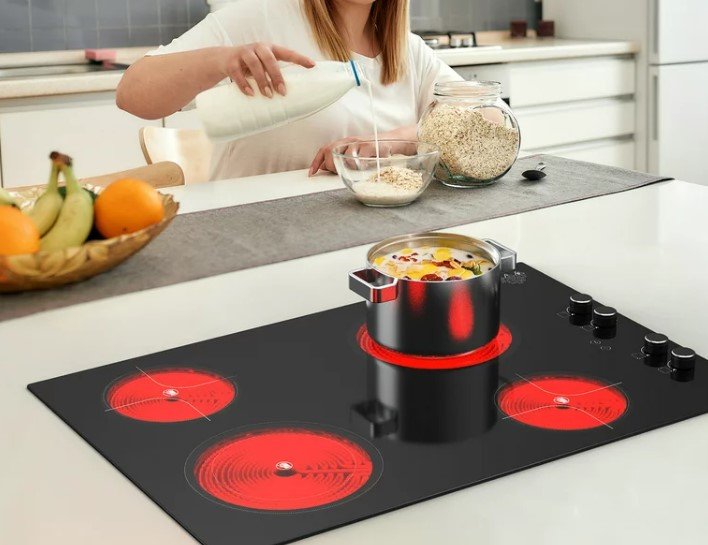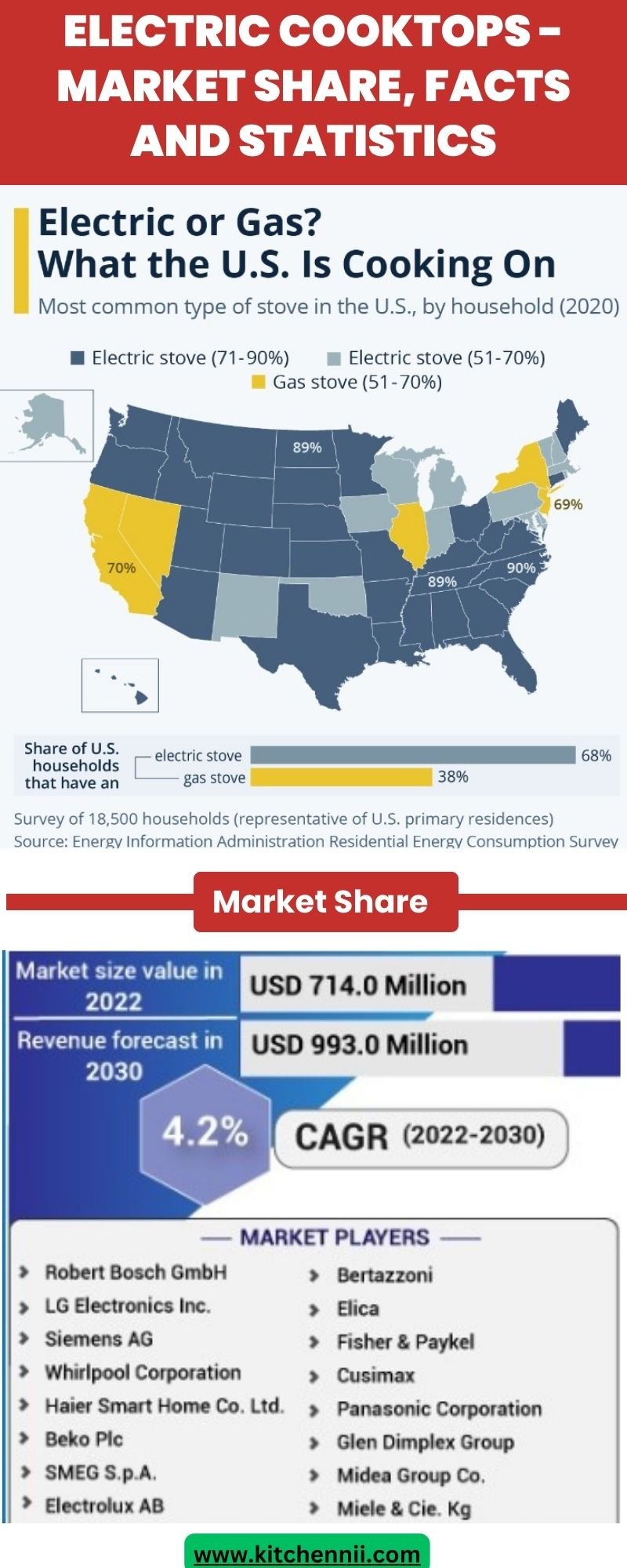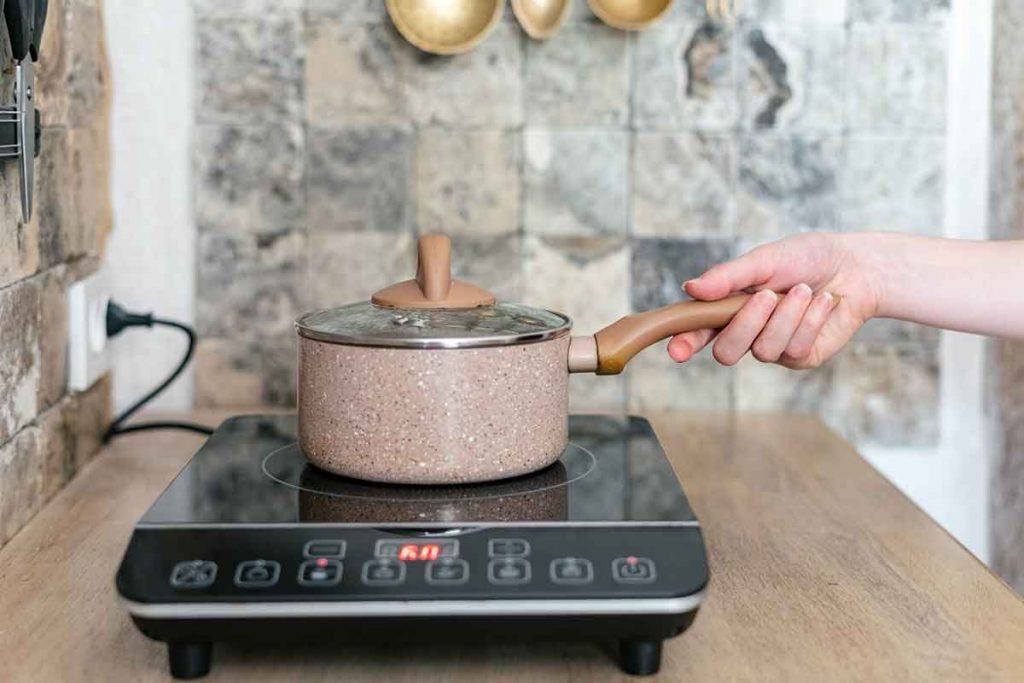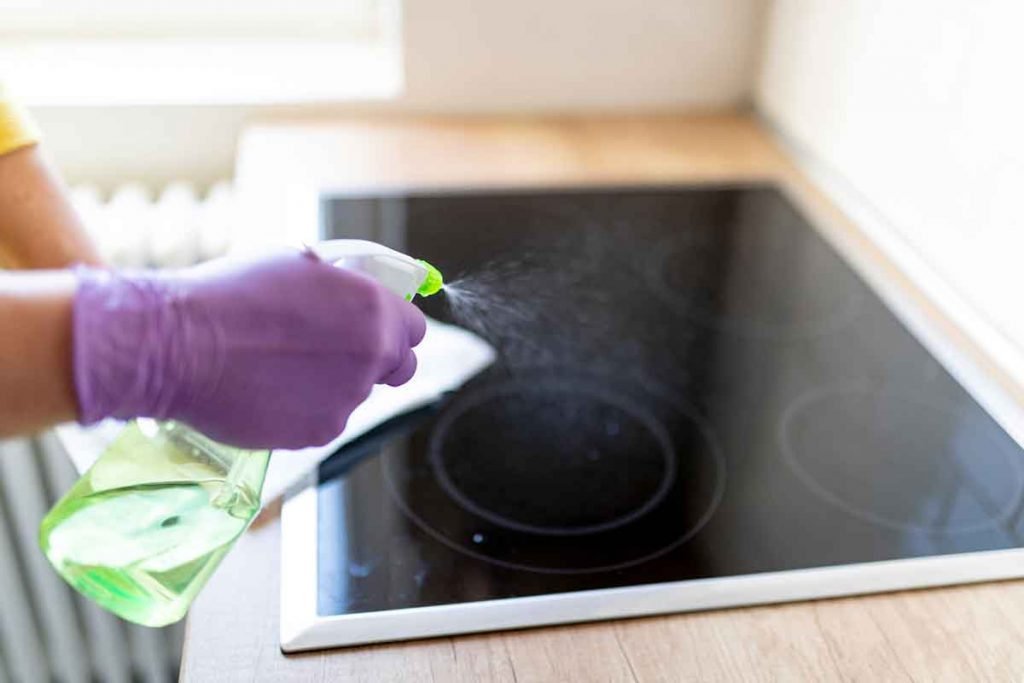If your stove has seen better days, it might be time to upgrade to an electric cooktop, and we will tell you why. These stoves offer you precise cooking power with the latest technologies, not to mention safety features.
According to the U.S. Department of Energy, over 40% of households today use electric ranges for stovetop cooking.
Numbers don’t lie, as you’ll see below.
Looking to get an electric cooktop? Check out our reviews on the best electric stoves today – both countertop and portable models.
Electric cooktops – Market Share, Facts and Statistics Infographic
The Science Behind Electric Cooktops
Electric models first appeared in the early 1900s but have come a long way since those exposed coil burners.
| Statistic | Value |
|---|---|
| Average kWh used annually by electric cooktop | 731 kWh |
| Typical wattage range of electric cooktop burners | 1200W – 3700W |
| Average yearly energy cost for electric cooktop (at $0.12 per kWh) | $87 |
| Average energy usage of radiant electric cooktop | 756 kWh/year |
| Average energy usage of induction cooktop | 612 kWh/year |
| % of U.S. households using electric cooktops | 32% |
| Average lifespan of an electric cooktop | 10-15 years |
| Average cost of electric cooktop repair | $200-$400 |
Electric ranges harness the power of passing electrical currents through resistive metal heating elements. When current flows through the element, called a burner, it meets resistance which converts electricity into heat.
These burners generate a magnetic field which causes molecules in the pan above to vibrate rapidly, creating thermal energy that cooks your food. The more power to the element, the stronger the magnetic field and the faster your pan heats up.
Power levels for electric ranges are measured in watts, typically ranging from 1,200W for smaller burners up to a whopping 3,700W for ultra-high heat. For context, a typical incandescent light bulb uses 60 watts. Multiply that by 50x or more for an electric burner!
Types of Electric Cooktops
There are three main varieties of electric cooktops, each with their own pros and cons:
1. Coil Cooktops
Coil cooktops utilize exposed circular heating elements, commonly referred to as burners. The electric current heats up a metal coil underneath the cooking surface, which then transfers heat directly to the cookware above it.
Pros
- Very affordable, often the most budget-friendly cooktop option
- Familiar and intuitive to use with knob controls
- Heating coils are durable and long-lasting
Cons
- More difficult to clean around exposed coils
- Cookware needs to match the coil size
- Coils can burn out over time and may need replacing
2. Radiant/Ceramic Glass Cooktops
These electric cooktops feature flat glass-ceramic surface panels housing the electric heating elements underneath. The smooth glass surface contains spills for quick cleaning.
Pros
- Seamless glass surface creates a sleek modern look
- Easy to wipe down ceramic or glass after cooking
- Options for frameless or stainless steel trim designs
Cons
- Glass surface prone to scratches from sliding pans
- Delayed response time as glass heats up first
- Damaged glass requires full cooktop replacement
3. Induction Cooktops
True, induction cooktops are categorized as electric models, but are a bit different from what talking about something quite different. You see, Induction cooktops use electromagnetic energy to directly heat up ferrous cookware above the surface. No heating element – the pan itself becomes the heating surface.
Pros
- Very energy-efficient – less wasted heat compared to other electric types
- Quick, precise responsiveness for temperature control
- Cool-to-touch surface apart from the cookware
- Easy cleaning with a smooth glass surface
Cons
- Requires compatible magnetic cookware
- Noisy vibration and buzzing from some pans
- Expensive compared to other electric cooktop types
Many brands now offer combination cooktops with both induction and radiant elements, blending the benefits of both technologies in one model.
Do Electric Cooktops Use a Lot of Electricity?
Compared to standard kitchen appliances, electric ranges are one of the more power-hungry products due to those intense heating elements. Exact energy use depends on factors like:
Cooktop type – Induction uses 10-20% less energy than radiant or coil.
Burner size – Larger elements over 2,000W use more electricity.
Frequency of use – Daily cooking requires more energy than occasional use.
According to EnergyStar, the average electric cooktop consumes around 731 kWh per year. At the average electricity rate, that equals about $70 annually in energy costs.
To put usage into context, here is how electric cooktops compare to other kitchen appliances according to EnergyStar typical annual energy consumption:
- Electric oven – 307 kWh
- Refrigerator – 361 kWh
- Dishwasher – 234 kWh
- Electric cooktop – 731 kWh
Let’s look at it even further:
| Electric Stoves Wattage | Hours of Use per Day | Total Energy Use | Total Energy Cost |
|---|---|---|---|
| 2,000 W | 1 Hour | 730 kWh / year | $100.156 / year |
| 2,500 W | 2 Hours | 912.5 kWh / year | $125.195 / year |
| 3,000 W | 3 Hours | 1095 kWh / year | $150.234 / year |
| 3,500 W | 4 Hours | 1277.5 kWh / year | $175.273 / year |
| 4,000 W | 5 Hours | 1460 kWh / year | $200.312 / year |
| 4,500 W | 6 Hours | 1642.5 kWh / year | $225.351 / year |
| 5,000 W | 7 Hours | 1825 kWh / year | $250.39 / year |
So electric cooktops do require significant power. Next let’s look at factors impacting energy use and how to conserve electricity.
Factors That Affect Electric Cooktop Power Consumption
The most significant factors determining an electric cooktop’s power draw during cooking include:
- Burner size – Larger 6-9 inch elements use far more electricity than smaller 5-inch burners. Match burner to pan size.
- Temperature setting – Higher heat settings draw exponentially more power. Use lower temp settings when possible.
- Cookware material – Pans that conduct heat poorly require more energy to heat up. Use quality cookware suited for electric.
- Duration – Continuously running an element at max uses more electricity than intermittent on-off.
With radiant and coil cooktops, heat not absorbed by the pan is wasted. Induction cooktops channel energy directly into cookware, making them up to 20% more efficient.
How to conserve power when cooking with an electric stove
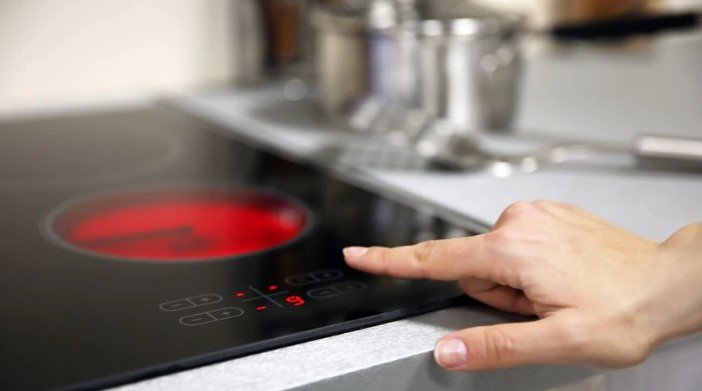
Electric ranges provide incredible cooking performance, but all that high heat can consume significant electricity. Fortunately, with some savvy techniques, you can still enjoy the precision of electric cooktops without getting burned by higher energy bills.
Here’s what we are talking about:
Match Cookware Size to Element
Electric range elements operate most efficiently when cookware makes full contact with their surface. Using an oversized 8-inch burner for a small 1-quart pot wastes energy in heating the unused cooktop area.
Always opt for elements that closely match the pan size. Heat will transfer into the pan effectively without excess heat dissipating around it. It’s better to use a smaller element on low power than an oversized one on high.
Start High Then Lower Heat
Take advantage of electric elements’ rapid heating by bringing water to a boil or pan to temp on the highest setting first. Once at the desired temp, immediately lower the heat to maintain simmering or cooking.
Starting pans on max power first, then reducing to medium or low uses less net energy than gradually raising to temp on a medium setting.
Use Lids
Pop a lid on pots and pans to retain heat that would otherwise escape. Cooktop elements have to work harder to replace lost heat energy. Let lids do part of the work for you.
For dishes needing longer cooking times, only lift the lid briefly to stir and check doneness. Keeping lids on as much as possible makes the electric elements’ job easier.
Shut Off Shortly Before Done
As food reaches doneness, the residual heat will finish cooking it off the burner. Avoid overcooking by switching off electric elements 5-10 minutes before food is complete.
Let carryover heat from the hot pan or pot finish the dish rather than running burners longer than needed. Just monitor as food rests to prevent under-cooking.
Avoid Preheating Empty Pans
It’s tempting to turn on elements in advance to preheat pans before cooking, but this guzzles electricity with no purpose. Only activate electric burners once food or liquid is already in the cookware.
The food itself will absorb the initial heat energy rather than wasting it heating an empty vessel. Start the preheating process only once the ingredients are loaded.
Limit Oven Peeking
We all love to check on roasting meats or bubbling casseroles. But every peek into the hot oven releases the precious heat you paid for. This forces the electric oven to run harder bringing temps back up.
Use the oven light instead of opening the door to satisfy curiosity about how dishes are progressing. Leave pans undisturbed until the minimum suggested cooking time is reached.
Delay Self-Cleaning
While very convenient, an electric oven’s self-cleaning mode consumes vast amounts of power. Initiate self-cleaning cycles only when truly needed rather than for minor spills or staining.
Hand clean ovens periodically instead to prolong the time between energy-draining self-clean cycles. Only use this feature every few months when grime builds up.
Bonus Tip: Run Large Loads
When using the electric oven, be sure to fill it up! Make the heating energy worth it by cooking main dishes alongside sides, roasted veggies, and baked goods simultaneously.
Batch cook or meal prep to maximize oven space. The oven uses the same power whether it’s half full or packed tight. Take advantage by loading it up.
Safety Tips for Electric Cooktops
While very safe overall when used properly, electric ranges call for basic precautions. Here’s what you need to know:
- Keep flammable items away – Don’t store plastics, paper, etc. near the cooktop.
- Prevent spills from dripping onto elements – Sugary spills can damage the cooktop.
- Avoid scratching the glass surface – Sliding pans can scratch and shatter the glass.
- Supervise children – Lock controls if needed to prevent accidental activation.
- Handle hot pans carefully – Use mitts and avoid grease splatter.
- Check for damaged cords – Don’t use if a power cord is frayed or cracked.
- Clean up spills promptly once cooktop cools – To avoid baked-on messes.
How do you clean an electric cooktop?
It’s quite simple. Check out the process below:

How-to-Clean-Electric-Stove-Top Infographic.pdf
Key Takeaways
Ready to shop for your perfect electric cooktop? With this comprehensive guide, you have all the savvy info needed to choose the model that best fits your cooking style and kitchen needs.
Common Questions
Do electric cooktops use a lot of electricity?
Electric cooktops are one of the more energy-intensive appliances, using around 731 kWh annually. Larger burners and frequent use increase electricity consumption.
Are electric cooktops safe?
Electric cooktops are very safe if basic precautions are followed. Keep flammable items away, prevent spills from dripping into the cooktop, and use child safety locks.
